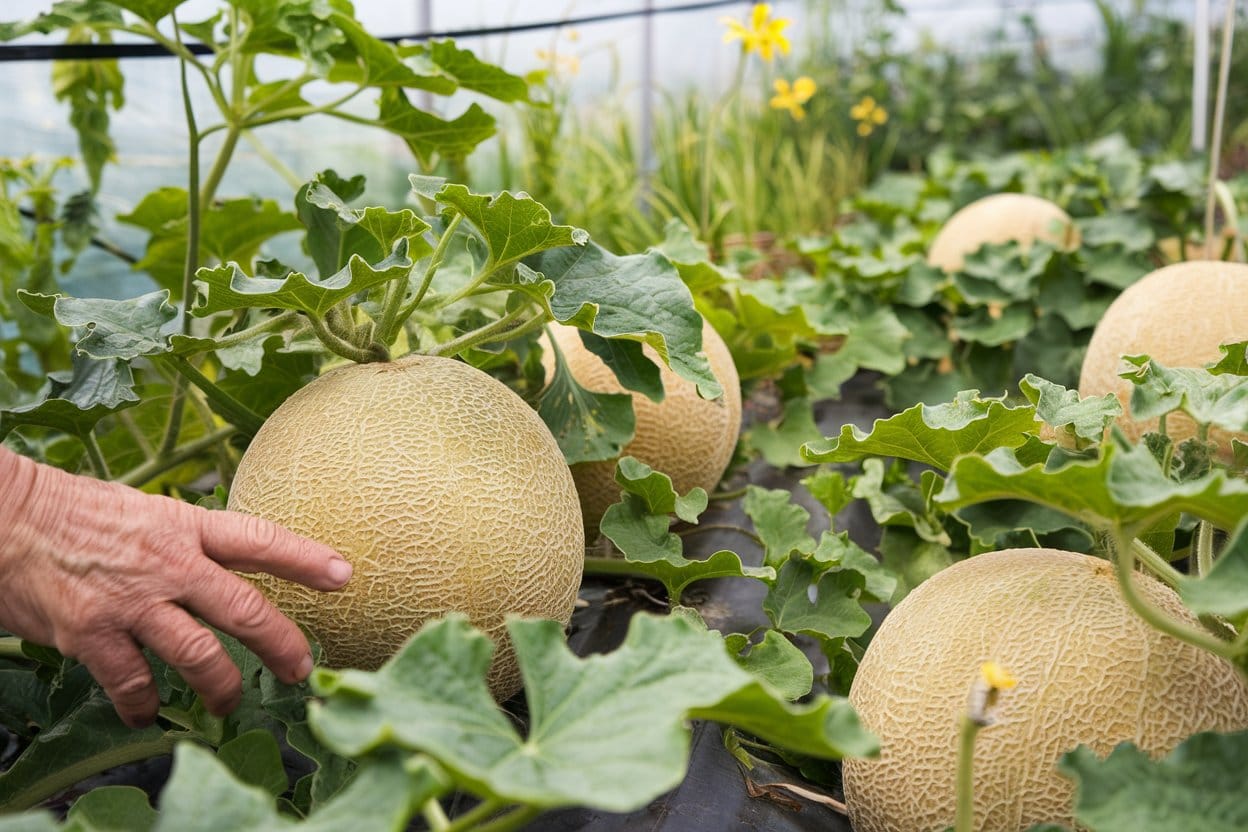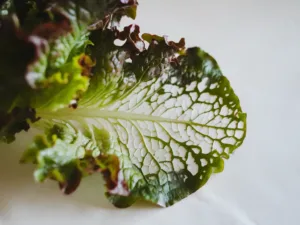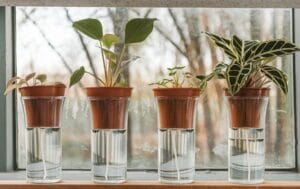Melons are among the more demanding plants in hydroponic cultivation, but the reward is immense. Once you get the hang of it, you’ll be thrilled with the yield. A significant advantage of hydroponics is the control over all growth conditions. You can precisely adjust temperature, light, and nutrients to create the perfect growth environment. This leads to healthy plants and sweeter, juicier fruits.
Another advantage is space savings. Unlike traditional cultivation, melons in hydroponics do not require large gardens or huge beds. With the right support from trellises, they grow compactly and make efficient use of the available space. Especially if you live in a city or have limited garden space, this is a real plus. You can create your own little oasis – even on the balcony!
The Best Melon Varieties for Hydroponics – Which Ones to Choose
Not all melon types are equally suitable for hydroponic cultivation. To achieve the best results, you should choose varieties that grow more compactly and ripen in a relatively short time. Here are three varieties that have proven themselves in hydroponics:
- Honeydew ‘Earligold’: Known for its early ripening and sweet taste, this variety requires less space than many others, making it particularly well-suited for smaller hydroponic systems.
- Muskmelon ‘Minnesota Midget’: With its compact growth form and small yet extremely sweet fruits, this variety is ideal for cultivation in tight systems.
- Watermelon ‘Golden Midget’: One of the earliest watermelon varieties suitable for hydroponics. It produces smaller fruits, practical for indoor cultivation, and has a surprisingly golden hue.
With these varieties, you are well-equipped for successful cultivation. Remember that melons need space for their root system and fruits, so plan your system accordingly!
The Perfect Hydroponic System for Melons
For growing melons hydroponically, you need a system that supports both the roots and the heavy fruits. Compared to other plants, melons have quite extensive root systems, and the fruits themselves can weigh quite a bit. Therefore, not all systems are ideal for melon cultivation.
A Deep Water Culture (DWC) system works particularly well. Here, the roots grow directly into a water basin filled with nutrient solution, allowing the plants a constant supply of water and nutrients. Alternatively, you can opt for the Nutrient Film Technique (NFT), where the plants grow on a slightly inclined channel through which the nutrient solution flows. This system is especially suitable for smaller melon varieties or if you want to save space.
No matter which system you choose, make sure to provide trellises. Melons tend to spread out, and the fruits need support to prevent them from falling to the ground. A well-supported system keeps your melons healthy and minimizes space requirements.
Proper Cultivation of Melons in Your Hydroponic Setup
The cultivation of melons is the first crucial step towards a successful harvest. The process begins with selecting the right seeds. You should opt for open-pollinated or F1 hybrids specifically bred for indoor or hydroponic cultivation. The germination process requires some patience, as melons have a longer germination time than many other plants.
It’s best to start your melon seeds in germination boxes or seedling cubes that you can easily transfer to your hydroponic system. Melons like it warm, so an ambient temperature of 25–30 °C is optimal for germination. Place the seeds about 1-2 cm deep in the substrate and keep the environment consistently moist but not too wet to avoid mold formation.
After 7–10 days, the first seedlings should be visible. Once they are large enough and have developed their first true leaves, you can carefully transfer them to your hydroponic system. Make sure that the roots have good contact with the nutrient solution to boost growth.
The Best Substrate for Growing Melons Hydroponically
The right substrate is crucial for the success of your melon plants. Since melons develop strong root systems, they need a substrate that provides both enough support and good aeration to prevent root rot. At the same time, the substrate should be able to retain enough water without becoming too wet.
Coconut fibers are a popular choice in hydroponics because they offer excellent water retention while being light and airy. They allow the roots to develop well without the risk of overwatering. Rockwool is also a good option as it provides good drainage while still efficiently retaining water. Perlite or a mix of perlite and vermiculite can also be used, especially if you prefer a lightweight substrate.
Regardless of the substrate you choose, make sure it is sterile and free from pests to minimize the risk of diseases from the start. Melons are sensitive to changes in their root area, so it’s important to use a substrate that is stable and durable.
Optimal Temperature for Melon Growth
Melons love warmth. To optimally support the growth of your melons in hydroponics, you should ensure that the temperature remains in the right range both day and night. For germination, temperatures between 25–30 °C are ideal. In this warm environment, seeds germinate faster and more vigorously.
During the growth phase, you should keep the temperature during the day at around 22–26 °C. While melons are heat-tolerant, consistent, moderate warmth helps promote stable and even growth. At night, temperatures can drop slightly but should not fall below 18 °C, as this could slow growth.
A temperature drop in cooler months can lead to problems, so consider using a heat mat or heater for your hydroponic system to stabilize conditions. Also, make sure to avoid extreme heat – too high temperatures can cause stress and affect fruit development.
More Light for Sweeter Melons – The Right Lighting
Melons need a lot of light to grow and develop sweet fruits. In an indoor hydroponic system, you need to ensure that your plants receive enough artificial light, especially if you cannot rely on natural sunlight. For optimal fruiting, melons require at least 12 hours of light per day, with 14–16 hours being ideal.
LED lamps are the best choice for growing melons hydroponically, as they are energy-efficient and provide the right light spectrum. Blue light promotes vegetative growth, while red light supports fruiting. The best option is a combination of both spectrums to maximize the growth and development of your melon plants.
You should also ensure that the lamps are placed at the right distance from the plants. Too close could burn the leaves, while too far could lead to weak growth. A distance of about 30–50 cm is generally ideal. If you are growing particularly light-intensive varieties, you can use reflectors to distribute the light more efficiently.
pH and EC – The Key to Healthy Melons
Monitoring the pH and EC values is one of the most important aspects of hydroponic melon cultivation. The pH value influences how well the plants can absorb nutrients. For melons, the pH should be between 5.8 and 6.2. A pH that is too high or too low can cause nutrient blockages and stunt the plants.
Additionally, the EC value (Electrical Conductivity) is crucial for measuring the right amount of nutrients in the solution. Melons require an EC value between 1.5 and 2.5 mS/cm, depending on their growth phase. During the growth phase, the ideal value is about 1.5–2.0 mS/cm, while during the fruiting phase, a slightly higher EC value of up to 2.5 mS/cm is optimal.
A pH and EC meter is indispensable in hydroponics. Regularly check these values to ensure that your melons have the best growth conditions. If the values are not correct, you can adjust the pH by adding pH-Up or pH-Down solutions and regulate the EC by diluting or adding nutrients.
The Best Fertilizers for Your Melon Cultivation
Melons are hungry plants, especially when it comes to developing sweet, juicy fruits. The right fertilizer is therefore crucial for a successful harvest. In hydroponics, it is important to use a balanced nutrient solution that contains all the necessary macro and micronutrients.
During the growth phase, melons primarily need nitrogen (N), which promotes leaf growth and strengthens the plant. In this phase, your fertilizer should have a higher nitrogen content. However, as flowers and fruits develop, the nutrient requirements shift. Now the plants need more phosphorus (P) and potassium (K), as these elements are crucial for fruiting and sugar buildup. A fertilizer with an NPK ratio of about 5-10-10 is optimal in this phase.
Additionally, pay attention to trace elements such as magnesium, iron, and calcium, which are important for the metabolism and health of the plants. Make sure to regularly renew the nutrient solution and keep an eye on the EC value to avoid over-fertilization, which could harm your plants.
The Perfect Harvest Time for Juicy Melons
Determining the right time to harvest your melons can be a bit tricky, but with a few tricks, you can ensure that your fruits are perfectly ripe and sweet. A sure sign that your melons are ripe is the sound test: Tap lightly on the melon – if it sounds hollow, it’s ready for harvest.
The color of the rind also provides clues to ripeness. For honeydews, the rind should take on a rich yellow color, while watermelons should have a slightly matte rind. The aroma is another indicator: Ripe melons often emit a sweet, aromatic scent. For watermelons, you can also observe the stem attachment. If it becomes dry and cracked, it’s time to harvest.
Harvest your melons carefully to avoid damaging the fruits and the plant. Use a sharp knife or scissors to cut the melons from the stem. If you harvest too early, the flavor may not be fully developed, so give the fruits a little more time if you’re unsure.
Protecting Your Melons from Diseases and Pests
As with any plant, there are certain diseases and pests that can make life difficult for you when growing melons hydroponically. But don’t worry, with proper care, you can prevent many problems.
Powdery mildew is one of the most common diseases in melons. It appears as a white, powdery coating on the leaves. To prevent powdery mildew, ensure good air circulation and avoid excessive humidity. If it does occur, you can counteract it with biological fungicides or a homemade baking soda spray.
Spider mites and aphids are also troublesome pests that can infest your plants. Spider mites can be identified by tiny webs between the leaves, while aphids often appear in large colonies and weaken the leaves. Natural predators like ladybugs or beneficial wasps can help here. Alternatively, you can use biological pest control products.
Through regular inspection and preventive measures such as clean working practices and cleaning your hydroponic systems, you can significantly minimize the risk of diseases and pests.
Special Tips for Maximum Melon Success
To ensure your melons thrive in hydroponics, there are a few special tips to help you get the best out of your plants. First, it’s important to provide enough space. Melons tend to spread out and need room to climb and develop well. Use sturdy trellises or nets to support the weight of the fruits. This also prevents the fruits from touching the ground, which could lead to rot.
Another tip is to prune the plants. If you notice that the plant is developing too many leaves or shoots, you can carefully trim them to promote fruit growth. Less energy goes into the foliage, and more is invested in fruiting.
Finally, make sure your melons have enough air circulation. Especially in indoor systems, heat and humidity can quickly build up, promoting diseases. A simple fan can work wonders here and also strengthen the plants, as they have to “fight” against the airflow, leading to stronger stems.
Now It’s Your Turn – Your Hydroponic Melons Are Waiting!
With the right knowledge and care, nothing stands in the way of your hydroponic melon success! You now have all the important information to successfully grow melons in your hydroponic setup – from choosing the right varieties, caring for the plants, to harvesting the sweet fruits.
Whether you’re growing on your balcony, in your garden, or even in your living room, hydroponics offers you the opportunity to get the best out of your melon plants. So grab your equipment, choose your melon seeds, and get started. Soon you’ll be enjoying your own home-grown melons – sweet, juicy, and soil-free!







